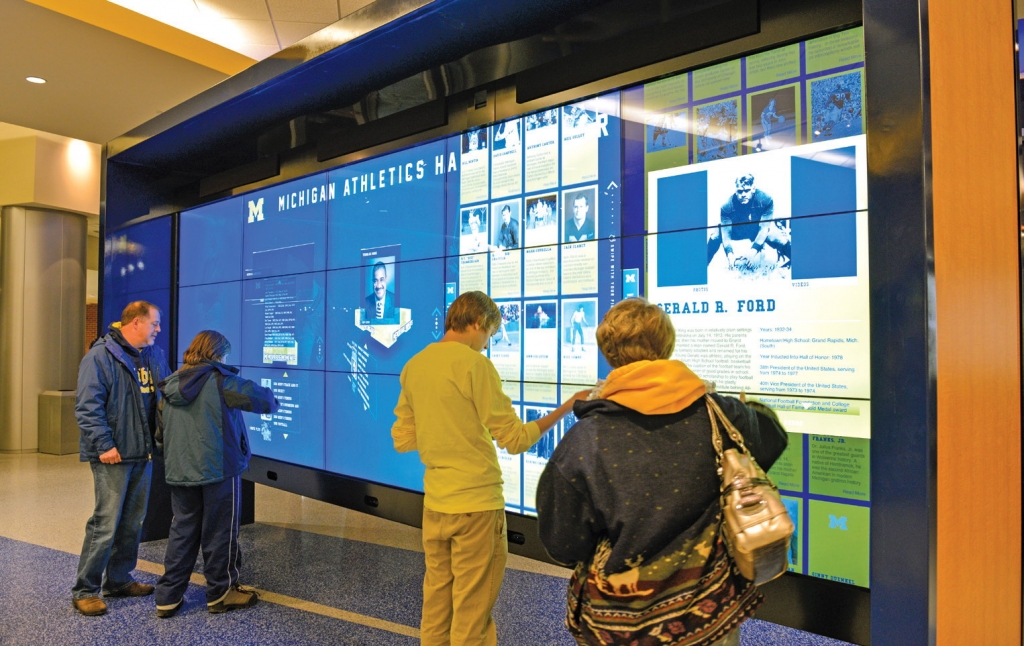Dimensional Innovations, an Overland Park, KS-based design and fabrication firm, has built and installed everything from 3-D signs to touchscreens in several high-profile stadia: the NFL’s Kansas City Chiefs’ Arrowhead Stadium, MLB’s Miami Marlins Stadium and the Consol Energy Center, home of the NHL’s Pittsburgh Penguins.
Increasingly, interactive touchscreens and displays have become a vital part of such stadium environ-
mental graphics. Today’s spectators are accustomed to interactivity through mobile devices and social media, and tactile screens extend such engagement.
“Interactive projects have several variables – screen technology, location, content and client goals,” Tucker Trotter, Dimensional Innovations’ owner, said. “Sometimes, we offer solutions to clients. In other cases, we provide specifications. Done right, it can be an amazing tool to drive memorable, unique experiences. They communicate with people when and where they want to be reached, which is important in today’s media-saturated world. But, the technology is only as good as the ideas behind it.”
University of Michigan representatives hired Dimensional Innovations to create an interactive display for the Crisler Center, the school’s on-campus basketball arena. All told, the system incorporates 54 monitors; it comprises 17 freestanding interactive displays, which feature information about the school’s various sports. Hall of Honor multi-touch video walls call up photos and information about Wolverine athletes inducted into the school’s hall of fame, and three Kids Zone interactives allow young ones to play games and engage in age-appropriate activities.
For the system, Dimensional Innovations sourced Planar Clarity Matrix’s LED-embedded LCD displays. Trotter said he liked their very narrow bezel, which allows a tight, seamless fit between monitors, and enables what he calls a “fluid, uniform digital canvas.”
He continued, “We had to integrate a diverse array of content. There are video-replay walls, donor information, recruiting updates, historical information and other material. From a design perspective, we also manage traffic flow and usage. The multi-touch video wall allows up to five users at once, so display location and setup are vital to making the system accessible.”
Advertisement
To ensure a program’s technical success, Trotter said the location of the data room is an important factor. He said running high-definition cable over long distances can require booster cables and other modifications that can increase cost and reduce efficiency. He said a tempered-glass surface to protect the screens is also essential, although he’s hopeful that improved screen technologies will someday make this step unnecessary.
“The most important thing to consider is the ‘why’ of the project,” Trotter said. “Many feel they need digital content merely for the sake of digital content, but that limits the technology’s effectiveness. It’s probably better to have no dynamic-display system than a poorly designed one. We start all conversations asking about the program’s purpose, its intended audience and the desired outcome.”



 Tip Sheet1 week ago
Tip Sheet1 week ago
 Photo Gallery2 days ago
Photo Gallery2 days ago
 Ask Signs of the Times4 days ago
Ask Signs of the Times4 days ago
 Real Deal1 week ago
Real Deal1 week ago
 Benchmarks6 days ago
Benchmarks6 days ago
 Editor's Note2 weeks ago
Editor's Note2 weeks ago
 Women in Signs1 week ago
Women in Signs1 week ago
 Photo Gallery1 week ago
Photo Gallery1 week ago







